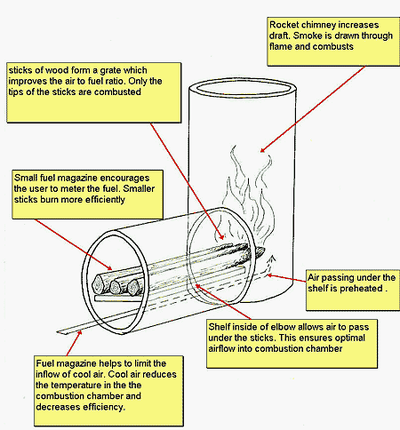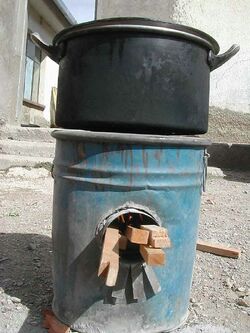Algernon99 (talk | contribs) m (Added section describing drawbacks of RocketStoves and section describing alternatives.) |
Algernon99 (talk | contribs) m (→Problems: Found more exact numbers from the UCS re wood burning) |
||
| Line 27: | Line 27: | ||
'''Overview:''' Fire based solutions, such as the Rocket Stove, allow cooks to make meals when the sun isn't shining or achieve temperatures that would be difficult without expensive parabolic cookers. However, they do have drawbacks: |
'''Overview:''' Fire based solutions, such as the Rocket Stove, allow cooks to make meals when the sun isn't shining or achieve temperatures that would be difficult without expensive parabolic cookers. However, they do have drawbacks: |
||
| − | * '''Pollution''' Though burning wood is nearly neutral in terms of the production of greenhouse gases, it is possibly the most injurious common form of generating heat in terms of particulate emissions and other pollutants. The Union of Concerned Scientists give wood burning an environmental rating of |
+ | * '''Pollution''' Though burning wood is nearly neutral in terms of the production of greenhouse gases, it is possibly the most injurious common form of generating heat in terms of particulate emissions and other pollutants. The Union of Concerned Scientists give wood burning an environmental rating of 21,000 per dollar of expenditure for common pollutants and 27,000 per dollar for toxic pollutants. By comparison, solid waste disposal, the next highest rated group, resulted in numbers of around 1400 and 300 respectively for the same categories. |
* '''Efficiency''' The book, "Capturing Heat II" by the [[Aprovecho Research Center]] suggests that without a skirt the Rocket Stove is only about as efficient as a well-run open fire. With the addition of a skirt that efficiency rises, but is still less than the 40% that is sometimes cited. |
* '''Efficiency''' The book, "Capturing Heat II" by the [[Aprovecho Research Center]] suggests that without a skirt the Rocket Stove is only about as efficient as a well-run open fire. With the addition of a skirt that efficiency rises, but is still less than the 40% that is sometimes cited. |
||
Revision as of 04:22, 25 June 2007

The Rocket stove is a variety of wood-burning cooking stove. It is easy to construct, with low-cost materials. These are low-mass stoves designed to burn small pieces of wood very efficiently. Cooking is done on top of a short insulated chimney. The stoves are typically constructed out of trash: tin cans, old stovepipes, etc. A skirt around the pot will help hold heat in, increasing the efficiency.
Rocket stoves use branches, twigs, small wood scraps, or just about any small combustible material. The pieces of wood or other material burn at their tips, increasing combustion efficiency, creating a very hot fire, and eliminating smoke. The low-mass stove body and insulated chimney assure that the heat goes into the cooking pot, not into the stove. Rocket stoves used in conjunction with hayboxes can save enormous amounts of fuel, cooking complete meals while using very few resources.
A related design, the rocket bread oven, is constructed using two 55 gallon drums, one inside the other. The outer drum is split open to create an insulated chimney space between the two drums and to allow for a doorway. Baking is done inside the inner drum--in a sealed compartment within the chimney, above the firebox.
Overview
It operates roughly twice as efficiently, and substantially more cleanly, than the open fire cooking methods still used in many areas of the world. Furthermore, the design of the stove requires small diameter lengths of wood, which can generally be satisfied with small branches. As such, sufficient fuel for cooking tasks can be gathered in less time, without the benefit of tools, and ideally without the destruction of forested areas.
Because these qualities improve local air quality, and discourage deforestation, the rocket stove has attracted the attention of a number of Appropriate Technology concerns, which have deployed it in numerous third-world locales (notably, the Rwandan refugee camps). This attention has resulted in a number of adaptations intended to improve convenience and safety, and thus the size of the target audience. The Justa Stove, for example, is a cousin of the rocket stove adapted for indoor use and family cooking needs.
Key features

A Rocket stove made from a barrel in Bolivia
The Rocket stove's main components are as follows:
- Fuel magazine - a short length of steel or ceramic pipe fitted horizontally into the base of the chimney
- Fuel shelf - holds the fuel clear of the bottom of the magazine to allow air to flow underneath
- Chimney - a metal box (such as a 5-gallon tin can) or pipe standing vertically and supporting the cooking vessel
- Heat exchanger - a tubular metal shield that forces hot gases from the chimney to pass over the sides of the cooking vessel
[Text for this page was borrowed from Wikipedia:Rocket stove and from http://www.lostvalley.org/haybox1.html.]
Problems
Overview: Fire based solutions, such as the Rocket Stove, allow cooks to make meals when the sun isn't shining or achieve temperatures that would be difficult without expensive parabolic cookers. However, they do have drawbacks:
- Pollution Though burning wood is nearly neutral in terms of the production of greenhouse gases, it is possibly the most injurious common form of generating heat in terms of particulate emissions and other pollutants. The Union of Concerned Scientists give wood burning an environmental rating of 21,000 per dollar of expenditure for common pollutants and 27,000 per dollar for toxic pollutants. By comparison, solid waste disposal, the next highest rated group, resulted in numbers of around 1400 and 300 respectively for the same categories.
- Efficiency The book, "Capturing Heat II" by the Aprovecho Research Center suggests that without a skirt the Rocket Stove is only about as efficient as a well-run open fire. With the addition of a skirt that efficiency rises, but is still less than the 40% that is sometimes cited.
- Maintainability Tin can stoves that this author has purchased or made have disintegrated due to rust after 3 to 6 months. Its possible to build longer lasting ones by surrounding the internal cans with a mix of sand and clay but of course that means that the stove will have a higher thermal mass resulting in greater fuel usage.
Alternatives/Variations
An interesting alternative -- at least in the developed world -- is the Sierra Zip stove. By pumping heated air into the combustion chamber quick high temperatures can be achieved with little energy wasted on thermal mass or warm-up time. Ensconced in a cooking system which skirts the cooking vessel, 4 oz of wood will give 2-3 minutes of gas-like cooking.
